The operation took 'one year, six months and nine days' to prepare and the results are 'absolutely brilliant.'
Ukrainian President Volodymyr Zelenskyy
Key Facts
- Operation Spider Web was planned by Ukraine over a year and a half to target Russian airbases deep inside Russia, including one 8,000 km from the border.

- On June 1, 2025, Ukraine launched 117 drones in a coordinated attack hitting five Russian airbases, destroying or damaging 41 strategic bombers, with at least 13 destroyed.

- The SBU claimed $7 billion in damage and said 34% of Russia's strategic cruise missile carriers at main airfields were hit in the operation.
- Satellite imagery confirmed destruction and severe damage to Russian bombers at multiple airbases, including Olenya and Belaya air bases deep inside Russia.
- Experts noted that while the attack complicates Russia's ability to launch missile strikes, replacing damaged bombers is difficult due to halted production of some models.
- Russia's air defense systems, including the S-400, failed to intercept the low-flying, slow-moving drones used in the attack, exposing critical vulnerabilities.
- India's layered air defense model, featuring systems like Akashteer, successfully countered drone attacks in Operation Sindoor, highlighting a contrasting approach to Russia's air defense vulnerabilities.
Key Stats at a Glance
Number of drones used in Operation Spider Web
117 drones
Preparation time for Operation Spider Web
18 months
Distance of farthest targeted airbase from Ukraine
8000 km
Number of strategic bombers hit
41 bombers
Number of strategic bombers destroyed
13 bombers
Estimated financial damage caused by Operation Spider Web
$7 billion
Percentage of strategic cruise missile carriers hit
34%
